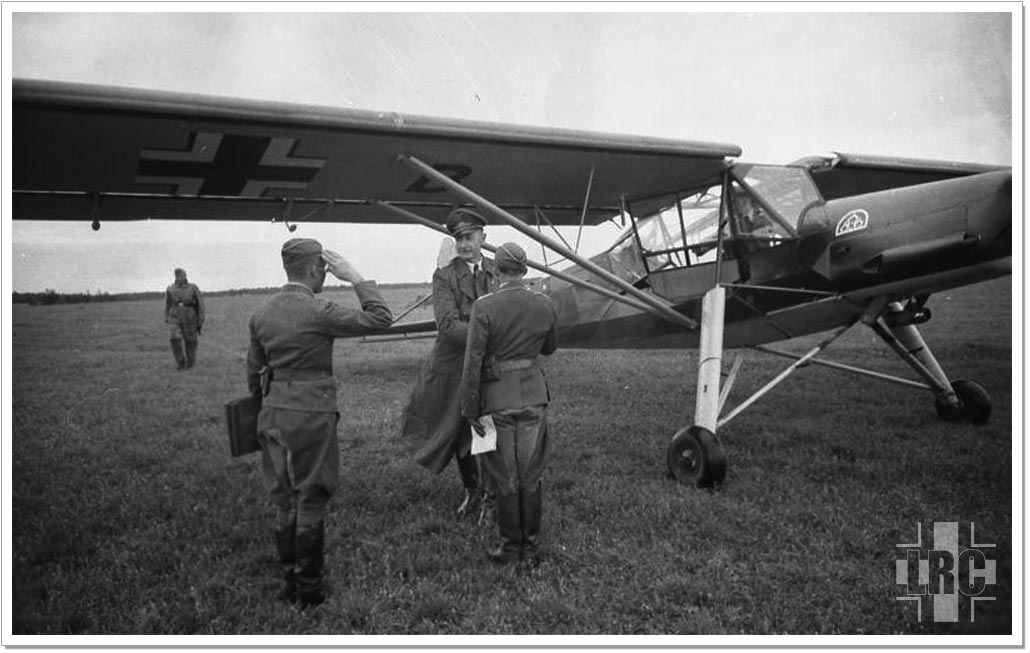Fieseler Fi 156
The Storch was deployed in all European and North African theaters of World War II, but it is probably most famous for its role in Operation Eiche, the 1943 rescue of deposed Italian dictator Benito Mussolini from a boulder-strewn mountain-top near the Gran Sasso. Even though the mountain was surrounded by Italian troops, German commando Otto Skorzeny and 90 paratroopers used gliders to land on the peak and quickly captured it. However, the problem of how to get back off remained. A Focke-Achgelis Fa 223 helicopter was sent, but it broke down en route. Instead, pilot Heinrich Gerlach flew in a Storch. It landed in 30 m (100 ft), and after Mussolini and Skorzeny boarded, it took off in 80 m (250 ft), even though the aircraft was overloaded. The Storch involved in rescuing Mussolini bore the radio code letters, or Stammkennzeichen, of "SJ + LL" in the motion picture coverage of the daring rescue.
On 26 April 1945, a Storch was one of the last aircraft to land on the improvised airstrip in the Tiergarten near the Brandenburg Gate during the Battle of Berlin and the death throes of the Third Reich. It was flown by the test pilot Hanna Reitsch, who flew Generalfeldmarschall Robert Ritter von Greim from Munich to Berlin to answer a summons from Hitler.

Fieseler Fi 156 Storch
[Source: Bundesarchiv]
A Storch was the victim of the last dogfight on the Western Front and another was downed by a direct Allied counterpart of the Storch, an L-4 Grasshopper, the military version of the well-known American Piper J-3 Cub civilian training and sport aircraft. The pilot and co-pilot of the L-4, lieutenants Duane Francis and Bill Martin, opened fire on the Storch with their .45 caliber pistols, forcing the German air crew to land and surrender.
Field Marshal Rommel used Storch aircraft for transport and battlefield surveillance during the North African desert campaign of World War II.
During the war a number of Störche were captured by the Allies. One became the personal aircraft of Field Marshal Montgomery. Others were used as the personal aircraft of Air Vice Marshal Arthur Coningham and Air Vice Marshal Harry Broadhurst, who acquired his Storch in North Africa, and flew it subsequently in Italy and North-West Europe.
The British captured 145, of which 64 were given to the French as war compensation from Germany.
Post World War II
The French Air Force (Armée de l'Air) and the French Army Light Aviation (Aviation Légère de l’Armée de Terre) used the Criquet from 1945 to 1958 throughout the Indochina War and the Algerian War. The Swiss Air Force and other mountainous European countries continued to use the Storch for rescues in terrain where STOL performance was necessary, as with the historically significant Gauli Glacier crash rescue in November 1946, as a pair of Flugwaffe-flown Storches were the sole means to get its twelve survivors to safety. After World War II, Storch aircraft were used in utility roles including agricultural spraying. Many Storches are still operational today and are commonly shown at air shows. In North America, both the Collings Foundation and the Fantasy of Flight museum have airworthy Fi 156 Storch aircraft in their collections.

Fieseler Fi 156 Storch
[Source: Bundesarchiv]
The French Air Force (Armée de l'Air) and the French Army Light Aviation (Aviation Légère de l’Armée de Terre) used the Criquet from 1945 to 1958 throughout the Indochina War and the Algerian War. The Swiss Air Force and other mountainous European countries continued to use the Storch for rescues in terrain where STOL performance was necessary, as with the historically significant Gauli Glacier crash rescue in November 1946, as a pair of Flugwaffe-flown Storches were the sole means to get its twelve survivors to safety. After World War II, Storch aircraft were used in utility roles including agricultural spraying. Many Storches are still operational today and are commonly shown at air shows. In North America, both the Collings Foundation and the Fantasy of Flight museum have airworthy Fi 156 Storch aircraft in their collections.
Sources:
Gunston, Bill & Wood, Tony - Hitler's Luftwaffe , 1977, Salamander
Books Ltd., London
, 1977, Salamander
Books Ltd., London
Wikipedia: Fieseler Fi 156
Gunston, Bill & Wood, Tony - Hitler's Luftwaffe
Wikipedia: Fieseler Fi 156






